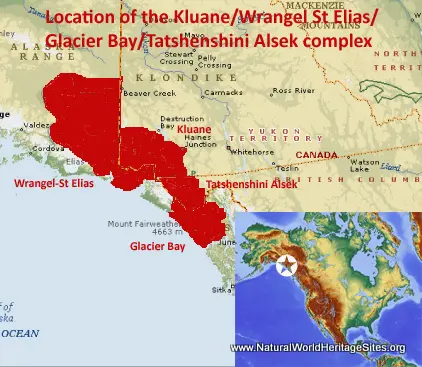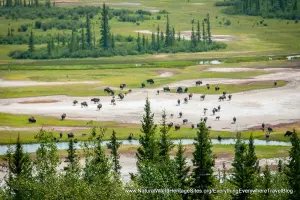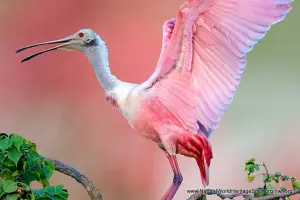EXPLORE Kluane/Wrangel St. Elias/Glacier Bay/Tatshenshini Alsek/Aerials/Richard Droker with this slideshow, check the location map and get all the facts and information below.
For slideshow description see right or scroll down (mobile). Click to view slideshow
Location and Values: The Kluane/Wrangel St. Elias/Glacier Bay/Tatshenshini Alsek reserve complex is a vast tract of land and sea – twice the size of Ohio, or three times the size of Belgium – that straddles the border between Canada and the USA. It ranges from 500m below sea level to the summits of some of North America’s highest peaks at elevations exceeding 5,000m. There are more than 200 glaciers, including some of the world’s largest and longest glaciers, making up the largest non-polar ice-field in the world. The spectacular scenery includes a diversity of coastal and marine environments, fjord-like inlets, snow-capped mountains, ice cliffs and glaciers, as well as deep river canyons. The area is tectonically active and ongoing geological and glacial processes give rise to correspondingly dynamic ecological processes. Nature remains in a truly pristine condition, allowing the natural interactions of predator and prey, involving grizzly bears and salmon, wolves and caribou, dall sheep and mountain goats. The marine component of the site supports congregations of whales and other marine mammals which migrate to these annual feeding grounds during summer. Here hump-back whales famously cooperate in bubble-net fishing, an extraordinary behaviour.
Conservation Status and Prospects. According to IUCN’s Conservation Outlook Assessment (2020) the conservation status of the Kluane/Wrangel St. Elias/Glacier Bay/Tatshenshini Alsek reserve complex is ‘good, with some concerns’. The IUCN report notes that this vast wilderness remains in a pristine condition where natural ecological processes prevail. The main concern in the longer-term relates to the potential impacts of climate change, which is already causing the rapid retreat of glaciers and may result in more profound and far-reaching ecological changes in both the marine and terrestrial realms.
Links:
Google Earth
Official UNESCO Site Details
IUCN Conservation Outlook
UNEP-WCMC Site Description
Birdlife IBA
Slideshow description
The slideshow ‘tells the story’ of the Kluane/Wrangel St. Elias/Glacier Bay/Tatshenshini Alsek /Aerials/Richard Droker reserve complex, focusing on the Glacier Bay area, which provides the most popular access for visitors. The rocky headlands, sheer-sided mountains and ice-blue glaciers in this area provide a spectacular introduction to this massive world heritage site, accessible by cruise ship. In the bays and inlets, visitors can observe a diversity of marine and terrestrial wildlife, including harbor seals hauled up on floating ice platforms, sea otters playfully bobbing up and down in the calm waters, and whales breaching with a thunderous splash of water. On suitable rocky outcrops close to the water’s edge seals congregate, while grizzly bears search the rocky shoreline for suitable morsels to eat, alongside black oyster catchers and mountain goats. Bald eagles can be observed soaring around the ice cliffs and diving for fish, while further inland moose and caribou are grazing the mossy hillsides, under the gaze of wolves. This is truly a remarkable wilderness!
The following Flickr photographers and other sources are acknowledged with thanks for their contributions to this slideshow: Alexander Shchukin, Amarnath, Anna Borenstein, Arthur LaBar, Alaska magazine, Alaska Mountain Guides, Bud Ellison, Celebrity Cruises, Christopher Chan, John Cornforth, CulturalHeritageOnline, David Bahr, Fred von Lohmann, Gail Hampshire, geospatialservices.org, Glacier Bay Lodge, USFWS, Google Sites, Mark Kelley, Hector Mota, Huffpost, James McLarnan, Jasperdo, Jeffery Beall, Jerry & Pat Donaho, John6536, Wikipedia, Jonathan, Jonathan Irish, Kimberley Vardeman, Kool Cats Photography, Larry Koester, Lindblad Expeditions, Lloyd, Matt Zimmerman, Moon Travel Guides, mpr news, National Park Service, Northwest Navigation Co, Shutterstock, Pontla, Richard Ricciardi, sharetheexperience.org, Twitter and World Journeys.
Factfile
Website Category: Marine & Coastal;
Lakes, Freshwater Wetlands & Glaciers;
Temperate Grasslands, Steppes, Shrub-Lands & Tundra;
Area: 98,391 km2
Inscribed: 1979 (extended 1992, 1994)
Criteria:
- Exceptional natural phenomenon (vii);
- Outstanding natural beauty (vii);
- Geological features (viii);
- Ecological processes (ix);
- Natural habitat for biodiversity (x);





